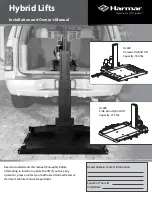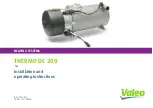
OPERATION
4-36
HySpeed HT2000LHF
Instruction Manual
7
Straightness of the Cut Surface
A typical plasma cut surface is slightly concave.
The cut surface may become more concave, or convex. Correct torch height is required to keep the cut
surface acceptably close to straight.
A strongly concave cut surface occurs when the torch-to-work distance is too low. Increase the arc
voltage to increase the torch-to-work distance and straighten the cut surface.
A convex cut surface occurs when the torch-to-work distance is too great or the cutting current is too
high. First, reduce the arc voltage, then reduce the cutting current. If there is overlap between different
cutting currents for that thickness, try the consumables designed for the lower current.
Additional Improvements
Some of these improvements involve trade-offs, as described.
Smoothness of Cut Surface (Surface Finish)
• (HyDefinition and HT4400 only) On mild steel, a higher concentration of N
2
in the O
2
-N
2
shield mixture may
produce a smoother cut surface.
Trade-off: This may produce more dross.
• (HyDefinition and HT4400 only) On mild steel, a higher concentration of O
2
in the O
2
-N
2
shield mixture may
increase the cutting speed and produce less dross.
Trade-off: This may produce a rougher cut surface.
Piercing
• The pierce delay must be sufficiently long that the arc can pierce the material before the torch moves, but
not so long that the arc “wanders” while trying to find the edge of a large hole.
• A higher shield gas preflow may help blow the molten metal away during piercing.
Trade-off: This may reduce starting reliability.
Note: When piercing at maximum thicknesses, the ring of dross that forms during the pierce may
be high enough to contact the torch when the torch begins to move after the pierce is
complete. A “flying pierce,” which makes the pierce while the torch is moving, may
eliminate the torch vibration that follows contact between the torch and the ring of dross.
How to Increase Cutting Speed
• Decrease the torch-to-work distance.
Trade-off: This will increase the negative cut angle
Note: The torch must not touch the workpiece while piercing or cutting.
Summary of Contents for HT2000LHF
Page 1: ...200 Volt Plasma Arc Cutting System Instruction Manual 803040 Revision 7 HySpeed HT2000LHF ...
Page 5: ......
Page 15: ...TABLE OF CONTENTS viii Hyspeed HT2000LHF Instruction Manual 6 ...
Page 109: ...MAINTENANCE 5 20 HySpeed HT2000LHF Instruction Manual 7 ...
Page 133: ......
Page 134: ...7 5 7 Figure 7 1 HT2000LHF Coolant Flow Diagram ...
Page 135: ......
Page 136: ...7 7 7 ...
Page 137: ......
Page 138: ...7 9 7 ...
Page 139: ......
Page 140: ...7 11 7 ...
Page 141: ......
Page 142: ...7 13 7 ...
Page 143: ......
Page 144: ...7 15 7 ...
Page 145: ......
Page 146: ...7 17 7 ...
Page 147: ......
Page 148: ...7 19 7 ...
Page 149: ......
Page 150: ...7 21 7 ...
Page 151: ......
Page 152: ...7 23 7 ...
Page 153: ......
Page 154: ...7 25 7 ...
Page 155: ......
Page 157: ......
Page 159: ......
Page 174: ...APPENDIX A ARGON HYDROGEN CUTTING AND GOUGING a 14 HySpeed HT2000LHF Instruction Manual 6 ...
Page 176: ...b 2 ...
Page 177: ...b 3 ...
Page 178: ...b 4 ...
Page 179: ...b 5 ...
Page 181: ...b 7 ...
Page 182: ...b 8 ...
Page 183: ...b 9 ...
Page 184: ...b 10 ...
Page 194: ...APPENDIX E AIR FILTERS e 2 Hyspeed HT2000LHF Instruction Manual 6 ...
Page 196: ...APPENDIX F AERATION MANIFOLD FOR CUTTING ALUMINUM f 2 Hyspeed HT2000LHF Instruction Manual 6 ...
Page 198: ...APPENDIX G IEC SYMBOLS g 2 Hyspeed HT2000LHF Instruction Manual 6 ...
















































